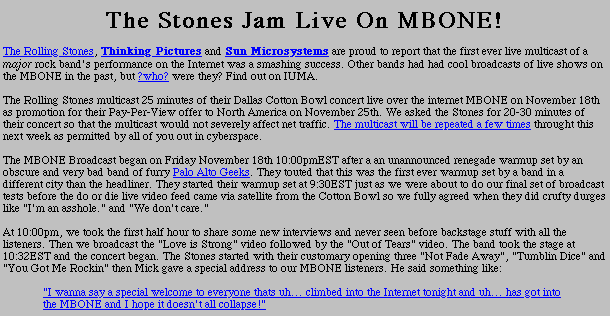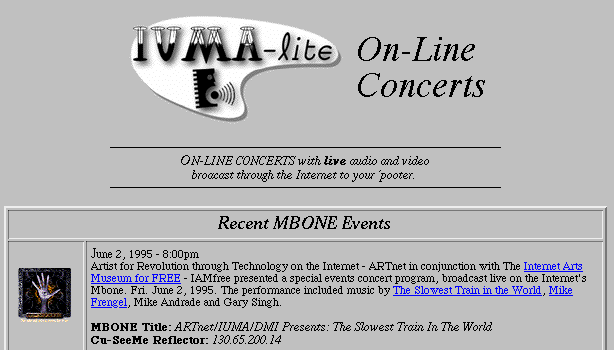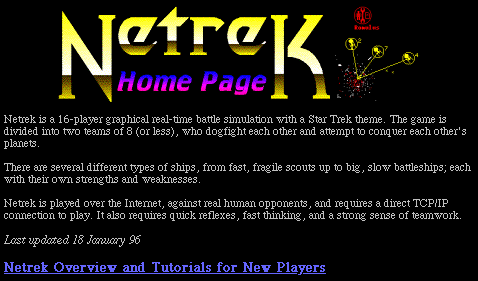
Figure 7-5: The Web page with details about the Rolling Stones' MBONE multicast in 1994.
MBONE: Multicasting Tomorrow's Internet
Television and movies are restricted to using audio and video signals, but the industry surrounding these two popular entertainment forms uses interaction and, in the awards programs and talk shows, live performances as well. Musical entertainment has long incorporated audio and video information, with live performances (and the resulting audience interactivity) considered one of the most important aspects of that entertainment mode.
Given the number of entertainment mediums already available, you may wonder why we need another one. We don't, probably. We can happily chew up untold hours by watching TV, sitting in front of the stereo, going to the movies, dressing up for the theater, playing computer games and board games, or -- to slightly alter Neil Postman -- amusing ourselves into oblivion. But one thing that humans seem to have proven over the course of this century is that we have a nearly insatiable appetite for entertainment, to the extent that shows even exist devoted solely to discussing entertainment media -- the making of entertainment, the reporting of entertainment, and so on -- that we watch on TV (itself an entertainment medium). We want to be entertained, and we're willing to spend a great deal of money to make it happen.
But will we pay for the MBONE? That's a question that we cannot yet answer, but the answer will at least partially determine if -- and how -- MBONE development continues. As a comparison, television was originally foreseen as an educational medium, but whether it would have survived, had the entertainment industry not co-opted it almost entirely, remains a subject for debate. Likewise, the Internet has undergone a shift in priorities, away from the scholarship and research purposes of its early years and towards business and entertainment. Entertainment dollars make a difference in North American economy, and the survival of many technologies ride on the infusion of some of those dollars.
The next sections look at three promising entertainment modes for the MBONE -- live performance, radio and television, and games.

Figure 7-5: The Web page with details about the Rolling Stones' MBONE multicast in 1994.
One of those links calls up another page, which shows the sites that tuned in to the MBONE concert. The interesting part about this page is the number of participants shown, as well as the range of locations from which the connections came. In November of '94, you needed more expensive hardware than you do today to connect to the MBONE, so a large MBONE audience was not guaranteed. Furthermore, some of these locations were "multicast viewing parties," something similar to an MBONE Super Bowl or World Cup party, where one person set up the connection and a bunch of friends gathered to experience the event. In this sense, the MBONE acted like a satellite television broadcast.
This fact is an important one: Although the MBONE may have the capability to be an interactive medium, nothing prevents it from working more or less like satellite broadcasting, with one source and many destinations. If people only use the MBONE in this way, it can't possibly develop to its full potential. One of the promises of the MBONE is that it will offer narrowcasting rather than broadcasting, catering to specialized interests and enabling full interaction between individual participants. Still, that the Stones' MBONE concert happened at all is significant in that marketers realized the commercial potential of the MBONE.
Much more interesting, from the standpoint of the MBONE's potential, was the concert that Sky Cries Mary gave, which was multicast on November 10, 1994, just eight days before the Stones' show. Figure 7-6 shows the main page for that event, stored at the Internet Underground Music Archive (http://www.iuma.com/), an organization that promises to provide regular MBONE entertainment. Here is an excerpt from the press release that you can access from that page:

Figure 7-6: IUMA
On Thursday, November 10, at 7:00pm PST, World Domination Records, WindsweptThe press release stresses the uniqueness of the event, but what's interesting is the contrast between its claim that the broadcast will reach tens of millions of Internet computers worldwide and the statement that you need to be at a site equipped with a sophisticated workstation and a high-speed connection to take part in the event.
Pacific, the Internet Underground Music Archive (IUMA), Starwave
Corporation, and Nick Turner of Firstars Management present the Seattle-
based techno/ambient rock band Sky Cries Mary performing a live show in
one of the first ever real-time rock concert broadcasts over the Internet.This multicast broadcast will reach tens of millions of Internet computers world wide.
This technology will allow anyone with access to a high end computer and a
high-speed network connection to access the broadcast and view the concert live.This experimental broadcast will utilize the fullest capabilities of the Internet today.
While not yet up to MTV specs, it will be in color with telephone-quality
audio. Note that this kind of broadcast is not at all possible using the
commercial online providers like America Online and Prodigy. This
represents a first step and is absolutely free of charge!The concert will be broadcast at 7:00 PM PST over the MBONE.
The MBONE is an experimental multimedia broadcast service, using the Internet as a
prototype of the broadband networks that will be provided in the future by
telephone and cable TV companies.To see the broadcast you must be at a site that has a powerful computer and a high speed
network connection. Currently only powerful workstations like those from
Sun Microsystems, Silicon Graphics, and Digital Equipment Corporation
can receive MBONE broadcasts.The network connection required is pretty heavy too, a T1 line connection is currently
required (a T1 line is the equivalent of 24 regular telephone lines, or 12
ISDN lines). Don't despair too much, a T1 line is a fraction of the
capability that is provided in many of the Interactive Television trials.
Many of the trials of ITV are using a technology called ADSL which
includes the equivalent of a T1 line and an ISDN line.If you already have access to MBONE broadcasts, just select "skycries", and
you'll be watching.
The most interesting item on the Sky Cries Mary site is the page of screen captures of the "whiteboard." Whiteboards are software items that are becoming prevalent in computer videoconferencing packages (whether on the MBONE or not). Whereas some conferencing software packages enable users to speak to one another, other (typically less expensive) packages offer a whiteboard instead for user-to-user communication. Even the speech-enabled packages contain the whiteboard, because it allows users to draw diagrams and demonstrate other communications that can be better handled visually than audibly. You'd expect a speaker in front of the room to use a whiteboard or blackboard for demonstration purposes, and there's no reason to expect conferencing software to offer less.
In this case, the whiteboard was available to anyone logged onto the MBONE to watch the concert. The comments weren't exactly replete with memorable content, but the impressive thing is that the comments were made in real time, from many different locations, during the concert. Extend this concept to a series of different whiteboards, each dedicated to a different "subject," and you have the basis for interaction during entertainment events. If you've ever wanted to talk about an entertainment event while you were watching it, you'll know how valuable that capability can be.
Sky Cries Mary was on the MBONE through the efforts of the Internet Underground Music Archive (IUMA). IUMA, which lists numerous independent artists (and some who have signed with labels) among their acts, is constantly offering Internet experiments in the entertainment field. After you log on to the IUMA site (http://www.iuma.com/), click on Enter IUMA and then the What's Brewing link to see whether IUMA plans to provide any new MBONE multicasts. You won't find anyone as well known as the Stones, but many people consider that fact to be a plus. One of the MBONE's capabilities, after all, is to provide lesser known artists with a way of reaching the world.
Live performances on the MBONE are not restricted to musical concerts. Plays, poetry readings, ballets, and holiday choirs could use the MBONE as a forum for their productions as well. Setting up such a session takes planning, initiative, and frequently, corporate donations of equipment and connections, but it can be done.
Even for niche stations that now occupy positions on cable or satellite networks (such as the Home & Garden channel, the Cable Health Club, or the satellite TV network aimed solely at truckers on the road), the MBONE may prove a worthwhile investment, especially for early adopters. Cable and satellite subscribers now have an overwhelming number of channel choices, and their choices will only increase in the future. Because MBONE activity is still quite rare, television-type stations have a chance to define the MBONE's entertainment programming before the big players get hold of it. Once commercial interest in the MBONE increases, the paradigm will already be in place. This scenario is basically what happened with the Internet.
Television-like activity on the MBONE is practically non-existent as of this writing, however. The more interesting forays into the MBONE are the radio initiatives that include multicasting as a distribution strategy. The point is that you can now use the Net essentially for radio programming. With the advent of technologies such as RealAudio (http://www.realaudio.com/, also covered in Chapter 2), we will also begin to see "near-live" radio -- taped programming that is immediately converted to RealAudio format and placed on the Net within minutes of the original taping.
One possible use for this format is to invite listeners to hear the RealAudio file, then use existing Internet technology -- Chat and WebChat, or perhaps the MBONE itself -- to discuss the program in question. This use isn't an MBONE use, but because it combines multimedia and real-time communication, the effect is much the same.
The MBONE is more than capable of handling radio broadcasts. In fact, because of the lack of a video feed, it can support radio much better than videoconferencing, and provide several additional scheduled sessions. The problem is that radio, unlike television, tends to be a local phenomenon these days, so how radio programmers make use of the MBONE, as it becomes increasingly available, remains to be seen. In all likelihood, we'll hear short broadcasts of events not readily available elsewhere on our radio dials, and some material may be more promotional than informative.
By contrast, games on the Internet (or commercial services such as the ImagiNation Network) are designed for multi-player use, but in doing so they tend to sacrifice most multimedia features. What they gain, however, is the possibility of global, simultaneous game-play among large numbers of players. In other words, the Internet has the potential of bringing the "social" back into gaming.
The primary gaming technology on the Internet today is the MUD, or Multi-User Dimension. Initially designed to offer multi-player, fantasy- or science-fiction-text adventure games along the lines of the famous Zork (and hence called Multi-User Dungeons), today's MUDs are used for games and education (the latter in the form of MOOs or MUSHes). Although MUDs have a large following and can be extremely enjoyable to play, these games are still missing one important ingredient -- multimedia. When playing a MUD, you see text and only text, although some MUD designers are working to incorporate MUDs with the Web to offer visual representations of the places you visit in the game. For more on MUDs, see Yahoo, which links you to several MUD sites.
Other Internet games, such as the famous Netrek, offer real-time multi-player capabilities with a graphical component. Figure 7-7 shows an important Netrek information page, complete with a screen shot of the game in action. This 16-player arcade-style simulation is basically a computer game with multiple players, and it has enjoyed such success that some businesses and schools have banned it from their computers because it uses up too many resources. Despite its success, however, it pales beside most multimedia computer games (from a purely aesthetic perspective) and it barely scratches the surface of what can be done with Internet gaming.

Figure 7-7: Netrek Home Page, with links to information archives about the game.
Whether the MBONE will become large enough (from a bandwidth sense) to support long gaming sessions is uncertain. If it does, however, the gaming possibilities are endless. Consider the role-playing game, for example, made famous in the late 1970s (the days before home computers) by Dungeons and Dragons. In this game, one person (the gamesmaster) put together a "world" and a set of plot lines; the other players -- usually about six -- played the role of characters in that world, attempting to solve the plot. At its worst, D&D was, and still is, an exercise in juvenile stupidity. At its best, though, this type of game truly became interactive storytelling. To date, no computer role-playing game has come anywhere close to similar success at the storytelling level.
Games conducted over the MBONE may well offer a global version of that kind of gaming, perhaps with dozens of players and more than one gamesmaster. With real-time collaboration, whiteboarding, graphical maps, and all sorts of other paraphernalia, these games would bring a social element to computer gaming that it currently lacks in most cases, and in the process could conceivably develop an important new art form. This capability does not lie in the near future, but it is something to aim for. The problem is overload: game players tend to forget about things such as how long they've been online, and the MBONE has limited resources. But the potential is enormous.
Other types of games are possible as well, from checkers to Trivial Pursuit and Pictionary to even Charades. For many people, getting players into the same house to play a game is next to impossible; the MBONE can potentially solve that problem, and change the entire concept of social gaming in the process.